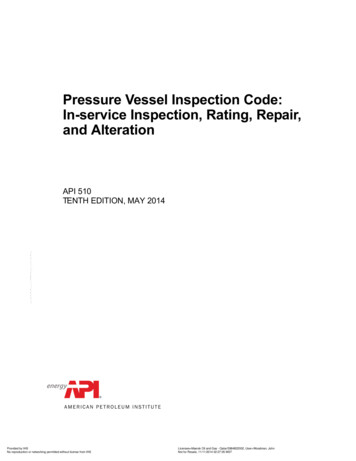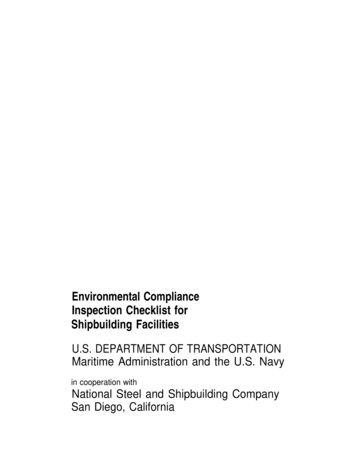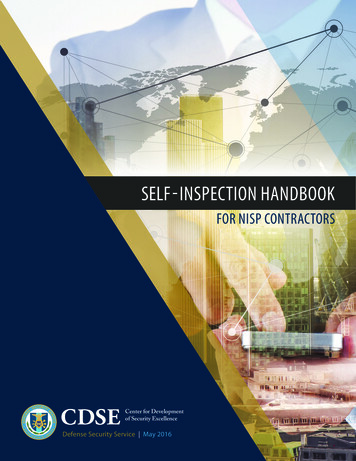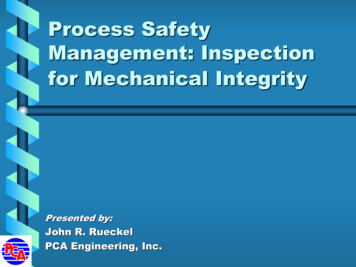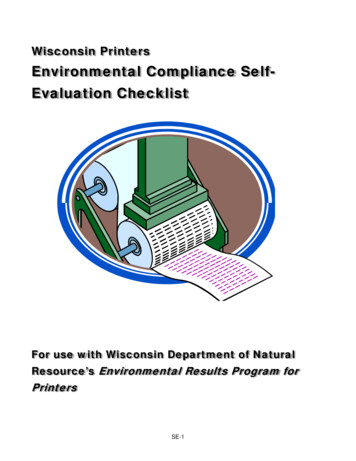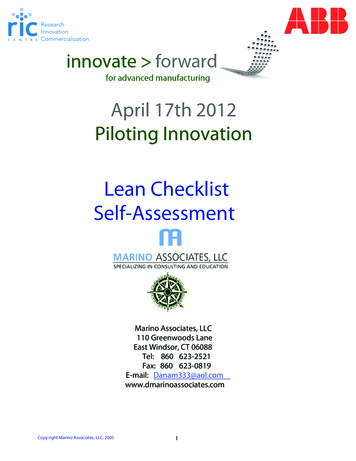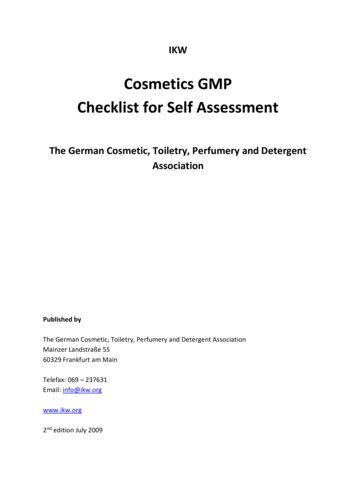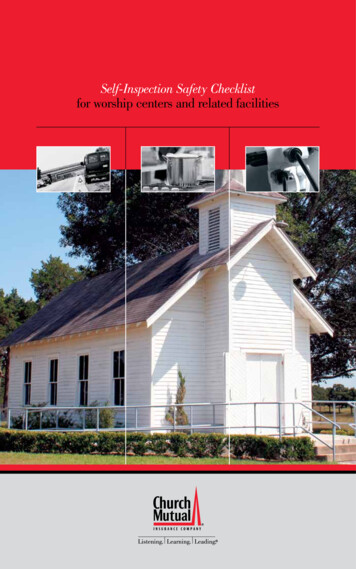
Transcription
Self-Inspection Safety Checklistfor worship centers and related facilities
Table of ContentsRisk Management Program.3Buildings and Grounds.4Playground Equipment.6Vehicles.7Fire Protection and Prevention. 8Electrical and Grounding.9Kitchen. 10Public Areas. 11Stairway Conditions. 12Access to Exits; Exit Markings. 13Machinery and Equipment. 14Employees and Volunteers. 16Security. 18Ergonomic Workstation Analysis. 19Ergonomic MaterialHandling Analysis. 20First Aid Care. 22Internet Resources.23Accidents, fires, thefts — somany of the tragedies thatoccur at worship centers canbe avoided with a few simpleprecautions.The Self-Inspection Safety Checklistis designed to help you prevent orreduce property, liability, theft, workers’compensation and vehicle losses.We suggest that you make copies of thisbooklet and use it to conduct safety andhealth inspections. We have organized thechecklist to correspond with areas of concern— kitchens, furnace rooms, outside areas, etc.— to make it especially easy to use as youwalk through your facility.An important, and often neglected, partof self-inspection is making sure there’sconsistent improvement in areas that needattention. Along with the checklist, we wouldsuggest you keep a calendar that notes thedates you do your inspections and includesa timetable for improvements.Many worship centers also form a RiskManagement Committee to help monitorproblem and improvement areas. A regularlyscheduled review and report on progress toyour church board helps lend authenticity andauthority to your efforts.The checklist is not a certified manual that willguarantee full compliance with federal, stateor local regulations. We suggest you use it asone element of your total risk managementprogram to help make your facility a safer,more secure environment for your employees,volunteers and entire congregation.Church Mutual customers may order ordownload additional copies of this checklistat no cost through www.churchmutual.com.Click “Safety Resources.” The checklist isavailable in English, Spanish and Korean.Church Mutual also has self-inspectionchecklists for educational facilities, camps andconference centers and senior living facilities.2
Risk Management Program:NeedsNotSatisfactory Attention ApplicableDo you have an accident prevention policyor mission statement?Are there written performance or accountabilitystandards and objectives for managers andsupervisors to: Reduce injuries and illnesses? Enhance workplace health and safety?Have you established compliance activitiesand programs?Is there a designated agency safetycoordinator?Do you have any health and safetycommittees?Have you established written safety rulesand practices?Do you offer health and safety trainingand education?Do you conduct health andsafety inspections/surveys?Do you practice loss preventionand control techniques?Have you established health and safetypromotion and awareness programs?Have you established accidentinvestigation and reporting procedures?Do you have a procedure for workers’compensation claims management?Do you offer early return to work programs?Do you have emergency response procedures,including notification of authorities, parentsand church oooooAction to be takenSafety TipMark areas that “Need Attention” throughoutthis checklist and establish a program toupgrade these concerns.Completed by: Date:Completed by: Date:Completed by: Date:3
Buildings and Grounds:NeedsNotSatisfactory Attention ApplicableAre roofs inspected annually?Are repairs performed promptlyto prevent building deterioration?Are stained glass windows covered with ashatterproof material to prevent damage?Are walkways kept clear of loose graveland other foreign materials?Are there any tripping hazards onthe sidewalk, lawn or parking lot?Are there potholes in the drivewaysor parking lot?Are parking lot traffic signs in good conditionand positioned for easy viewing?Are there parking blocks in the parkinglot? (They are a major cause of trip andfall injuries and should be removed.)Are driveway and parking lot chain barriersequipped with reflectors for visibility at night?Is the parking lot adequatelymarked and lighted?Is there exterior dusk-to-dawn lightingon all sides of the building?Are all exterior basement window wellscovered with a substantial covering orgrate that will hold at least 500 pounds?Is there a wheelchair-accessible ramp,and is it inspected frequently?For more information, ask forChurch Mutual’s bookletSafety OutsideYour Worship on to be takenMaintenance TipMake it a policy to clean gutters anddownspouts of leaves and debrisat least once a year.4
NeedsNotSatisfactory Attention ApplicableAre sidewalks and steps freeof raised cracks or chips?Are handrails securely anchored?Are fences in good repair?Are trees maintained and located soas not to allow access to upper floorwindows or roofs?Is there a separate shed to store paint,gasoline and other flammables?Are lightning protection systems in place?On older systems, do wires run directlyinto the ground?Cold Weather Concerns:Is snow removed promptly from entryways,sidewalks and parking lots?Are ice and other slick spots treated as soonas possible?Is snow and ice removed immediatelyfrom above doorways and walkways?Do you have a plan for removing heavy snowor ice loads from roofs to prevent collapse?Do downspouts direct water over walkwayswhere it can freeze and create a ooooooAction to be takenCompleted by: Date:Completed by: Date:Completed by: Date:5
Playground Equipment:NeedsNotSatisfactory Attention ApplicableDo surfaces around playground equipmenthave at least 12 inches of wood chips, mulch,sand or pea gravel, or are mats made ofsafety-tested rubber or rubber-like materials?Does protective surfacing extend at least6 feet in all directions from play equipment?For swings, surfacing should extend twice theheight of the suspending bar in backand front.Are play structures that are more than30 inches high spaced at least 9 feet apart?Is all equipment securely anchored?Is there dangerous hardware, such asopen “S” hooks or protruding bolt ends?Do openings in guardrails or between ladderrungs measure less than 3.5 inches or morethan 9 inches?Are there sharp points or edgesin equipment?Are there tripping hazards such as exposedconcrete footings, tree stumps and rocks?Do all elevated surfaces such as platformsand ramps, have guardrails to prevent falls?Are playgrounds checked regularly tosee that equipment and surfacing are ingood condition?For more information, ask forChurch Mutual’s bookletSafety at Your Playground.ooooooooooooooooooooooooooooooAction to be takenSafety TipChildren on playgrounds should becarefully supervised by at least two adultsto make sure they’re safe.Completed by: Date:Completed by: Date:6Completed by: Date:
Vehicles:NeedsNotSatisfactory Attention ApplicableDo you have a written policy banning the useof cell phones and other mobile devices whileoperating motor vehicles?Owned:Is the use of owned vehicles restrictedto official business or activities?Do buses and vans comply with staterequirements for lights, equipmentand color?Do drivers perform a pre-trip and post-tripinspection documenting vehicle condition,any mechanical problems and odometerreading before and after trips?Are vehicles routinely inspectedby a competent mechanic?Does the inspection include chassis, all lights,body, exhaust system, brakes, tires, steeringand interior?Are written repair and maintenancerecords kept for each vehicle?Are drivers instructed that under nocircumstances should the keys be keptin any vehicle when left unattended?Are periodic bus evacuation drills conducted?Are the driver and all passengers requiredto wear seat belts? (Buses are excluded.)Nonowned:Are all staff members, employees andvolunteers who use their vehicle forchurch or school business informedthat their liability and physical damagecoverage is primary coverage?Do individuals who use their vehicle for churchor school business provide the Risk Manageror Safety Committee with proof of insurancewith adequate liability limits?If someone’s vehicle does not appear to bereliable, it should not be used for church orschool business or activities.Are there established guidelines for minimumage limits for those using their vehicle forchurch or school business?(We recommend a minimum age of on to be takenCompleted by: Date:Completed by: Date:Completed by: Date:7
Fire Protection and Prevention:NeedsNotSatisfactory Attention ApplicableDo you have a fire prevention plan?Are fire doors in good operating condition andunobstructed, including their counterweights?Are all fire extinguishers checked and taggedannually by a qualified servicing contractor?Are all fire extinguishers checked monthlyby staff?Are all fire extinguishers properly mounted ona wall in a conspicuous location?Are specifically hazardous areas such asthe furnace/boiler room (Type-ABC) orkitchen (Type-K) equipped with a proper fireextinguisher in accordance with National FireProtection Association standards?Is each floor level (including balconies)equipped with a proper fire extinguisher(Type-ABC)?Are fire extinguishers placed so the maximumtravel distance does not exceed 75 feet?Are employees periodically instructedin the use of extinguishers and fireprotection procedures?Do you have a fire alarm system?If so, is the fire alarm system testedat least annually?Are all owned buildings which are occupied assleeping quarters equipped with early-warningsmoke detectors?Are all smoke detectors hardwired intothe electrical system and equippedwith battery backup?Are automatic sprinkler system water controlvalves, air and water pressure levels checkedweekly or periodically as required?Is good housekeeping maintained in thefurnace or boiler room?Is good housekeeping maintained instorage areas?Are hardwired carbon monoxide detectorsprovided for buildings equipped with fossilfuel heat sources and hot water heaters?Completed by: Date:Completed by: Date:8Completed by: ooooooAction to be taken
Electrical and Grounding:NeedsNotSatisfactory Attention ApplicableAre electrical outlets in nurseries and preschoolage classrooms equipped with spring-loadedor twist-type safety faceplates to preventchildren inserting objects into the outlet?(Plastic plugs are not recommended.)Are electrical outlets located near waterequipped with ground fault circuit interrupter(GFCI) type receptacles?Are portable electrical tools and equipmentgrounded or of the double insulated type?Are electrical appliances such as vacuumcleaners, polishers and vending machinesgrounded?Are any electrical cords frayed, crackedor dried out?Are properly grounded receptacles placedwhere machinery or tools are used?Are refrigerators, freezers, air conditionersand electrical water coolers grounded?Do extension cords being used havea grounding conductor?Are power strips or bar-type adapters usedto increase the number of receptacles ina wall outlet? (T-type multi-adapters arenot acceptable.)Are all unused openings (including conduitknockouts) in electrical enclosures and fittingsclosed with appropriate covers, plugs or plates?Are electrical enclosures such as switches,receptacles and junction boxes provided withtight-fitting covers or plates?Do you use the proper size fuse for eachcircuit in your fuse box?Are circuits identified on the fuse box cover?When electrical equipment or lines are to beserviced, maintained or adjusted, are necessaryswitches opened, locked out and taggedwhenever oAction to be takenCompleted by: Date:Completed by: Date:Completed by: Date:9
Kitchen:NeedsNotSatisfactory Attention ApplicableIs there an easy exit from the kitchen to theoutside of the building?Is the kitchen exit located away from thepotential source of a fire?Is the kitchen area, including appliances, walls,floors, etc., free of grease accumulation?Are overhead fluorescent and incandescentlights in food preparation areas protectedto prevent the possibility of glass particlescontaminating food should a light explodeor break?Is the kitchen fire extinguisher mountedon a wall near an outside exit?Is the fire extinguisher a Type-K?Are proper waste containers used forwaste food accumulation?Are waste containers emptied immediatelywhen filled?Is cooking equipment installed on anon-combustible floor surface with adequateclearance from combustible materials?If frequent cooking takes place, are exhausthoods equipped with removable filters andare explosion-proof lights installed abovethe cooking equipment?Are the hood, filters and exhaust duct cleanedon a regular basis?Does the frequency or type of cooking suggestthe installation of an automatic fire suppressionsystem in the hood and duct system?Is your hood fire suppression system inspectedand date tagged at least annually by acontractor certified for such inspections?Are kitchen gas range burners maintained sothey immediately ignite when the burners areturned on?Are refrigeration motors, cooling coils andcompressors free of combustible materialsand cleaned regularly?Is a mop conveniently located to quickly cleanup spills?Are hot pads and mitts readily available forhandling pots and pans?Is your kitchen area equipped withheat detectors?Completed by: Date:Completed by: Date:10Completed by: oooooooooAction to be taken
Public Areas:NeedsNotSatisfactory Attention ApplicableAre rugs, carpets and floor tiles periodicallychecked for tears, rips or chipping that couldcause tripping?Are rugs, carpets and floor tilespromptly repaired?Are “walk-off” mats used at all entrancesto collect grit, water, ice and snow?Are “walk-off” mats cleaned frequently?Are “Caution Wet Floor” signs used whenmaintaining floors or after cleaning up a spill?Is good housekeeping maintained andare all floor obstructions and trippinghazards removed?Are extension, telephone or sound equipmentcords on the floor or steps where they cancreate trip-and-fall hazards?Are emergency phone numbers postedby all telephones?Do glass doors or partitions have designsetched or applied to them in order to alertpeople to their presence?Are nursery and preschool areas situated sothat infants, toddlers and small children canbe swiftly evacuated?Are poisonous substances stored away fromareas where children congregate?oooooooooooooooooooooooooooooooooAction to be takenFor more information, ask forChurch Mutual’s bookletSafety Begins With People.Completed by: Date:Completed by: Date:Completed by: Date:11
Stairway Conditions:NeedsNotSatisfactory Attention ApplicableAre steps on stairs and stairways designed orprovided with a surface that is slip resistant?Are standard stair rails or handrails onall stairways with four or more steps?Are stairway handrails located between30 and 34 inches above the leading edgeof stair treads?Do stairway handrails have at least 1-1/2 inchesof clearance between the handrails and thewall or surface they are mounted on?Are stairway handrails capable of withstandinga load of 200 pounds applied in any direction?Where stairs or stairways exit directly into anyarea where vehicles might be operated, areadequate barriers and warnings provided toprevent employees, members and guests fromstepping into the path of traffic?Is the rise in concrete at entrancewaysidentified to prevent slips and falls?Is there proper illumination on stairways andaccess to light switches on both levels?Completed by: Date:Completed by: Date:12Completed by: Date:ooooooooooooooooooooooooAction to be taken
Access to Exits; Exit Markings:NeedsNotSatisfactory Attention ApplicableDo all emergency exits open in anoutward direction?Are all emergency exit doors equippedwith panic hardware?Are all emergency exits kept unlocked and freeof obstructions when buildings are occupied?Are there two exits, remote from each other,for each level of the building?Are exterior fire escapes accessible andwell maintained?Are all exits marked with a lighted exit signand also powered by an emergency source?Are exit route maps displayed at regularintervals throughout your facilities?Is emergency lighting tested regularly?Is it a policy to replace backup batteries inexit signs and emergency lights once a year?Are doors, passageways or stairways, thatare neither exits nor access to exits and whichcould be mistaken for exits, appropriatelymarked, “NOT AN EXIT,” “TO BASEMENT,”“STOREROOM” and the like?ooooooooooooooooooooooooooooooAction to be takenSecurity TipAll exterior doors should be equipped withnonremovable hinges to preventunauthorized access.Completed by: Date:Completed by: Date:Completed by: Date:13
Machinery and Equipment:NeedsNotSatisfactory Attention ApplicableAre heating and air conditioning systemsinspected at least annually by a qualifiedcontractor?Are boilers and hot water heaters equippedwith a pressure and temperature relief valve?Are lawn mowers and all gasoline-poweredequipment stored in a detached storagebuilding?Is limited storage of flammable andcombustible materials in accordance withNFPA Standard 30 or local ordinances?Are ladders maintained and in good conditionat all times?If a ladder is being used to gain access toa roof or upper platform, does it extend atleast 3 feet above the point of support?Are metal ladders prohibited from use in areascontaining electrical current?Are ladders equipped with nonslip safety feet?Are ladders stored indoors or otherwiseprotected from the elements?Are all power and hand tools kept ingood condition with regular maintenance?Are power tools with hazardous moving partsequipped with proper guarding?Is the organ turned off when not in useso that it cannot overheat and potentiallycause a fire?Are drive sheaves, belts, pulleys and othermoving parts of heating, cooling or otherequipment properly guarded to preventcontact?Is all lawn care equipment equipped withproper protective guarding and appropriatewarning notices?Is American National Standards Institute (ANSI)approved eyewear and hearing protectionprovided for staff members and volunteersinvolved in maintenance and lawn Action to be takenSafety TipAudio/video equipment on moveablecarts should be strapped downto prevent tipping.14
NeedsNotSatisfactory Attention ApplicableAre workers required to wear eyewear andhearing protection?Are point of operation guards in place?Is the mechanical power transmissionapparatus adequately guarded?Are saws
Accidents, fires, thefts — so many of the tragedies that occur at worship centers can be avoided with a few
